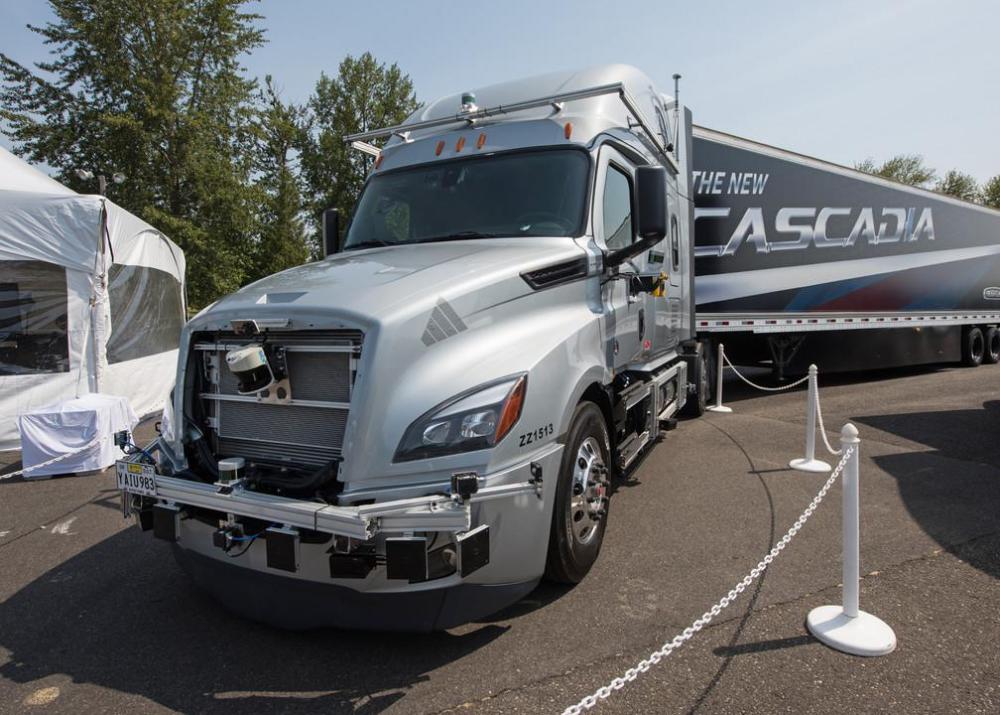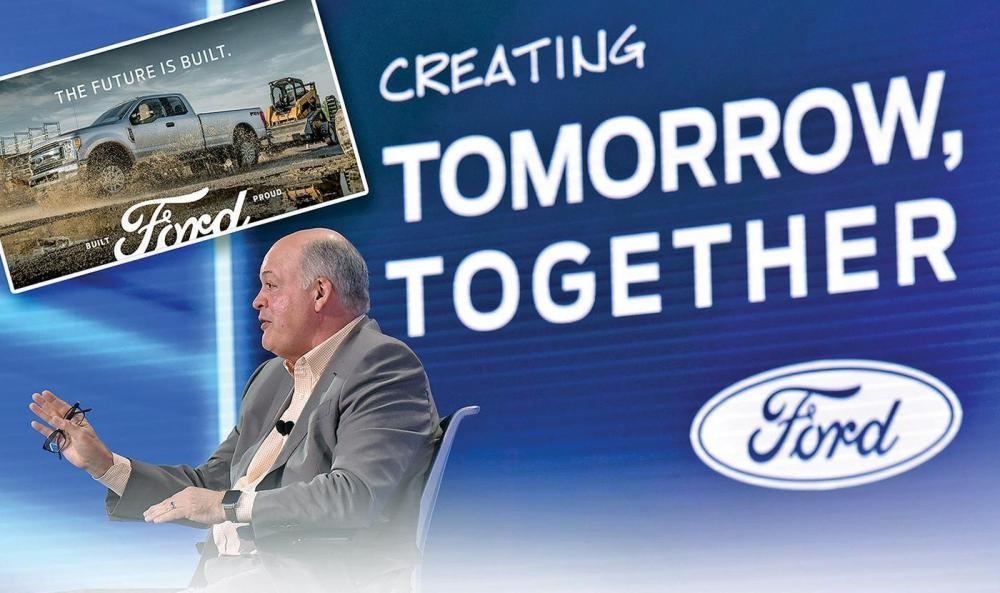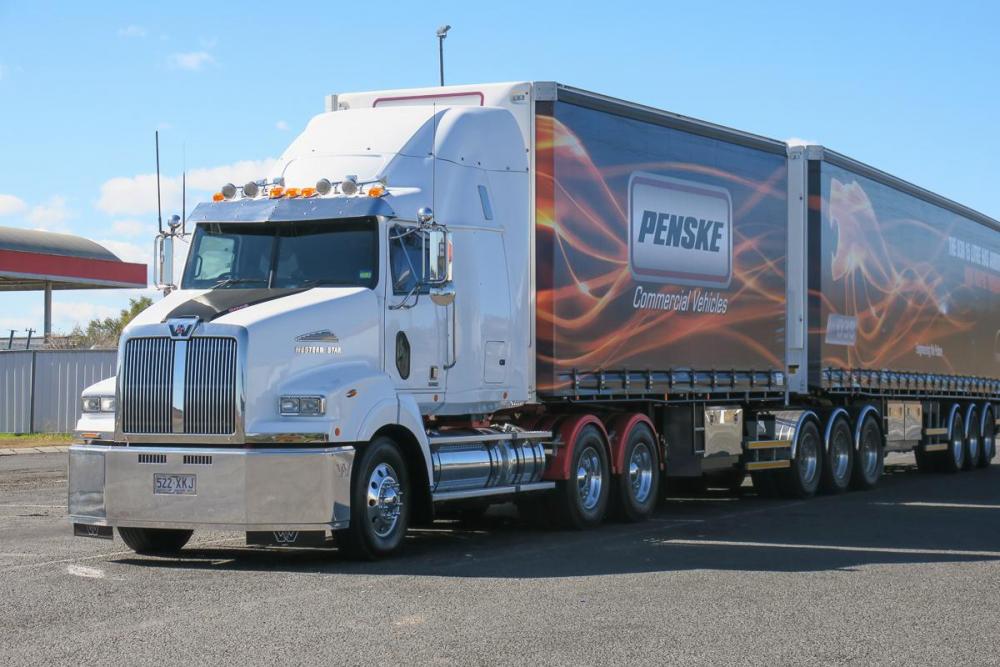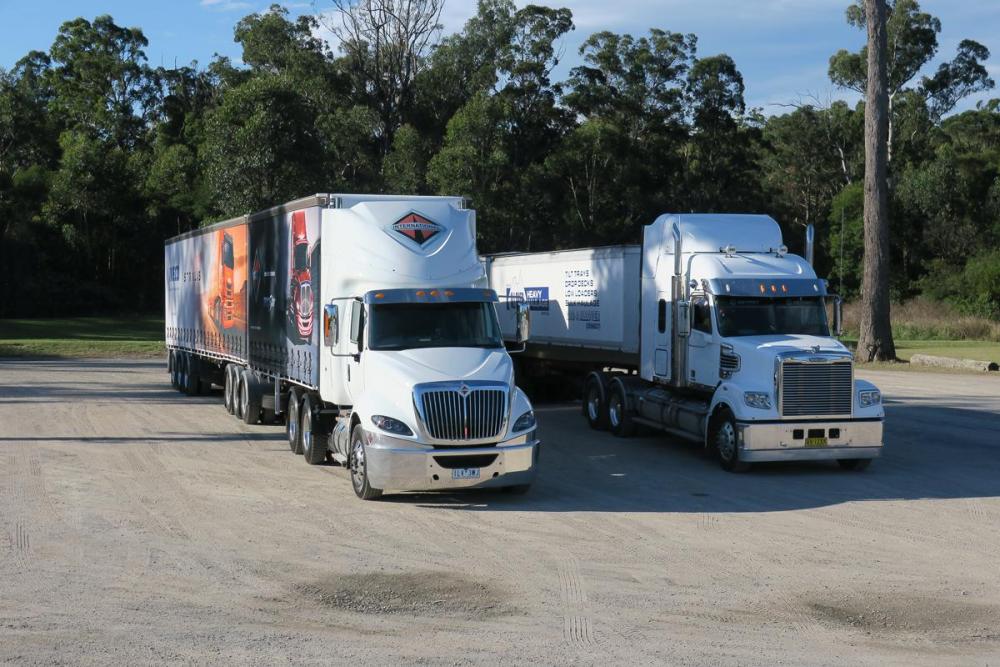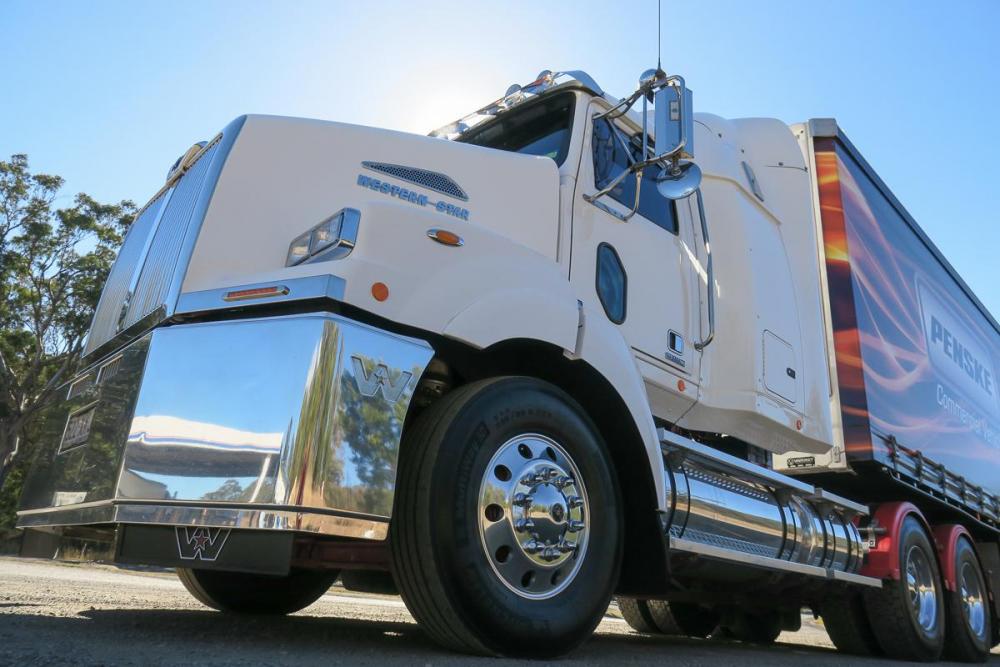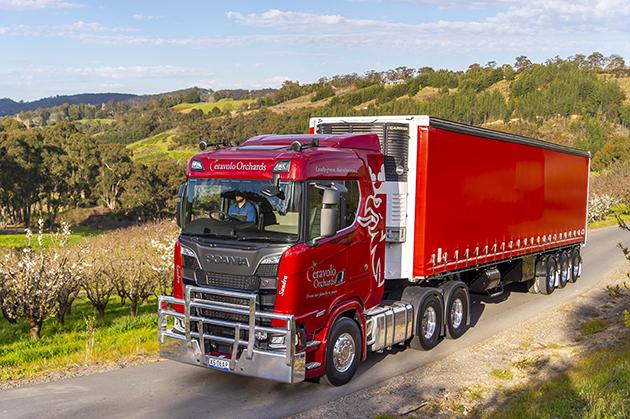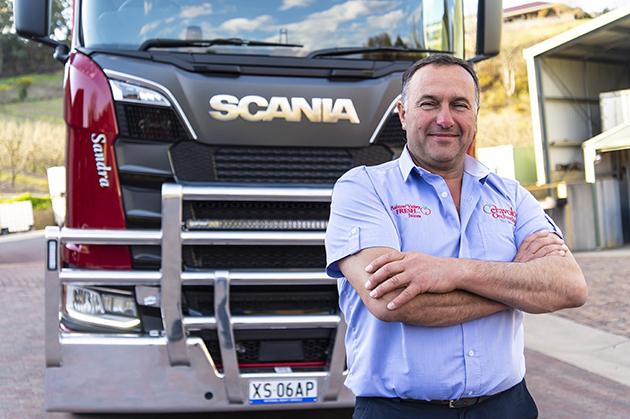
kscarbel2
Moderator-
Posts
18,886 -
Joined
-
Days Won
114
Content Type
Profiles
Forums
Gallery
Events
Blogs
BMT Wiki
Collections
Store
Everything posted by kscarbel2
-
Nick Carey, Reuters / October 22, 2018 Tesla CEO Elon Musk put electric heavy commercial trucks on the map in November 2017 when he unveiled the company’s futuristic, battery-powered Semi, booked hundreds of orders and said he would start delivering the vehicles by 2019. Now, it looks like 2020 could be the big year for electric big rigs. Incumbent truck makers are accelerating their electric truck projects toward launches that year, while Musk told investors in June production of the eye-catching Semi freight hauler should begin “basically (in the) first half of 2020” instead of 2019. Driven by regulatory pressure to cut diesel pollution, commercial truck makers have made a flurry of fresh announcements to deliver battery electric or hydrogen-fueled vehicles. They have landed orders from big fleet operators such as Walmart, United Parcel Service (UPS) and Anheuser Busch Inbev NV. The challenge is gauging how big the market for electric commercial trucks will be, especially outside of China. The limited range of most first-generation electric or hydrogen commercial trucks and a lack of charging infrastructure threaten to limit sales to short-haul operations. In China, regulators are considering a long-term plan to replace 1 million diesel big rigs with cleaner trucks, including electric models, and some Chinese ports and cities are banning diesel trucks, which could [will] significantly boost sales. In the United States, the outlook for electric truck demand is cloudier. Some analysts estimate that by the mid-2020s, U.S. annual electric truck sales may number only in the hundreds. Over the last 12 months, North American diesel and so-called semitruck orders totaled 497,000 units. Toyota’s experience at the Ports of Los Angeles and Long Beach illustrates the potential, and the problems for clean truck technology. The first of Toyota’s working hydrogen fuel-cell trucks was designed with a 200-mile (322 km) range for daily operations and has already logged more than 10,000 miles running short routes around the ports. The newer second iteration has a 300-mile range but that is still well short of the 1,000 miles or more diesel trucks can run between refueling stops. Toyota has not provided a production timeline, but executive program manager Chris Rovik said “so far we feel confident the technology is absolutely applicable to this type of use case.” Fueling infrastructure is a major headache for electric and hydrogen trucks. Hyundai commercial vehicle director Mark Freymueller describes a chicken-and-egg problem: Trucking companies are reluctant to buy trucks without fueling stations, but fuel station operators will not install them without trucking customers. Battery electric trucks can take hours to recharge and charging stations are scarce in most U.S. states. Hydrogen trucks can be refueled in about the same time as a diesel truck - but hydrogen refueling stations are even rarer, with most concentrated in California. “Fueling infrastructure is a very important first step,” said Chris Cannon, chief sustainability officer for the Port of Los Angeles. “The trucks may work great, but if they can’t get any fuel they can’t operate.” Last month, the California Air Resources Board (CARB) announced $41 million in grants to the port toward building 10 new hydrogen fuel-cell electric trucks to be developed by Toyota and Paccar unit Kenworth. The grant will also partly-fund two new hydrogen fuel stations to be built by Royal Dutch Shell Plc. Most manufacturers see short-haul routes such as drayage services to or from ports or rail yards as likely first adopters of electric or hydrogen trucks. “We think the first applications are going to be shorter haul,” said Denny Mooney, Navistar International’s vice president of engineering. “We’re going to start out where the business makes sense.” Tesla customers like Deutsche Post unit DHL, which has ordered 10 Semis, say they could save tens of thousands of dollars on maintenance and fuel annually. CEO Musk says the Semi’s range could hit 600 miles. But a spokesperson said running uphill with air conditioning on or running other appliances would cut that range. Many modern 18-wheelers contain televisions, fridges and other appliances. Package delivery giant UPS has pre-ordered 125 Tesla Semis and will use them on daily routes hauling packages between hubs and on UPS Freight routes between businesses - mostly shorter routes. “In many ways we are ideally suited to be an early adopter of this technology because we don’t have much long-haul business,” said UPS spokesman Glenn Zaccara. Tesla is working with potential customers including UPS, Pepsico and Anheuser-Busch to build charging stations at their facilities. Nikola Motor Co, a startup offering a fuel cell truck, has ambitious multibillion-dollar plans to build 700 U.S. hydrogen fueling stations over the next decade, starting along the major routes of Anheuser-Busch, which has ordered up to 800 trucks, says CEO Trevor Milton. Nikola has secured funding for those stations, he said.
-
Roger Nielsen, President and CEO - Daimler Trucks North America (DTNA) / September 21, 2018 At DTNA, along with our recent advancements in e-mobility and connected services, we’re also focusing on automated driving, an important third pillar of our technology strategy. Soon, we’ll be expanding our team and facilities by opening a new Automated Truck Research & Development Center in Portland, Oregon, near our headquarters. Here’s a quick look at our ongoing, expanding efforts into the leading edges of automated vehicle technology. If you have an engineering background and a desire to change to world with innovative new technology, send a resume and letter of interest to innovateDTNA@daimler.com, but here’s more. With heavy investments in both our new Automated Truck R&D Center in Portland, Oregon and our High Desert Proving Grounds in Madras, Oregon, we’re creating global hotspots of emerging technologies and innovation, zeroing-in on freight efficiency, safety, and driver experience. Our engineers in North America collaborate closely with colleagues around the world at Daimler Trucks locations in Stuttgart, Germany and Bangalore, India to form a global network of hundreds of engineers devoted to advancing automated driving technology. We leverage this depth and breadth of experience across Daimler’s vehicle divisions to include both commercial vehicles and passenger cars. As we make progress with automated trucks, we’ve been testing them on our state-of-the-art test tracks and on Oregon highways. In June, we demonstrated automated driving through vehicle pairing, incorporating advanced, vehicle-to-vehicle communications between two trucks and showcasing our high-tech safety systems. Paired vehicles essentially 'talk' to each other, collecting information such as position, speed, and braking status 50 times every second. As a result, trucks in an automated pair can respond to each other in coordinated fashion, much faster than a human. This allows the vehicles to travel safely at a close following distance, thereby reducing fuel consumption. To help us prepare for new levels of automation, our Data Collection Truck (pictured above) aggregates immense troves of real-world data from a range of sensors. Dozens of test runs have provided a wealth of data that help us adapt as we move forward with our typical, micron-level attention to detail. We’re not just developing technology for technology’s sake, though. Our new Automated Truck R&D Center is a hub for co-creation where customers, suppliers, and business partners alike can provide input that deepens our understanding of how this technology can help our customers increase their profitability. Our eyes are on the bottom-line impact—not just for our customers, but for society at large. That means safety and reliability come first, as always, and automated driving systems are no exception. Drivers remain at the center of any new development – even of a truck featuring highly automated driving technology. The opinion that the technology will not replace drivers was further validated by findings from a recent study, Preparing the Workforce for Automated Vehicles, conducted by the American Center for Mobility—a non-profit testing and product-development facility for future mobility. We’re not going it alone, either. We’re collaborating with other industry experts to help ensure that we’re at the forefront of the discussion of how the advancement of automated vehicles will impact safety, quality of life, and economic opportunity. Daimler has teamed up with the American Trucking Associations, FedEx, Toyota, Ford, Uber, Waymo, and Lyft to found the Partnership for Transportation Innovation & Opportunity (PTIO). Committed to collaborating with American workers, policy makers, and customers to find solutions through the common-sense adoption of automated driving technology, PTIO creates a powerful alliance for collaboration on the future of automated vehicles. Only through examining, listening and understanding potentially disruptive new technology from every angle can we remain responsible global stewards, as we develop and commercialize groundbreaking new tech. .
-
Hackett is sweating.
-
Amid unease, dealers get clearest look yet at Ford's restructuring plan Michael Martinez, Automotive News / October 22, 2018 LAS VEGAS — The last time Jim Farley stepped into the Bellagio hotel's Grand Ballroom to address a national meeting of dealers here, Ford Motor Co. was on the brink of crisis. It was April 2008, six months after Ford had lured Farley from Toyota to help it steer through a steep downturn. A decade later, Farley was in the same room, again addressing an uneasy retail network questioning Ford's future. "It's a comeback story, but it's a different comeback story," Farley said. "We just happen to have a lot more money in the bank, but we want it just as bad. We want to be the best." Ford also has an abundance of skeptics, including Wall Street analysts, anxious employees and some of the dealers it spent last week working to reassure. It has even started to see customer loyalty, a longtime strength of the Ford brand, dip slightly, prompting a newfound marketing focus on retention instead of conquesting. Ford used this year's annual dealer gathering to offer the clearest look to date at its plan under CEO Jim Hackett and to rally its retail body with an emotional appeal. It vowed to freshen showrooms through shorter product development cycles and revealed plans to add affordable nonsedan models to the lineup, alter vehicle allocations to raise profit margins and launch an edgy advertising campaign that plays up the company's history. Ford is trying to psych up its North American dealer body as it begins a difficult $11 billion global restructuring that will stretch into the next decade. While North American margins may be improving, Ford is losing money in key markets including China, Europe and South America and has indicated it plans to overhaul its operations in those countries. It's expected to post a decline in third-quarter earnings on Wednesday, Oct. 24. Leadership team turns out Ford has struggled to explain Hackett's vision for the company, and analysts have openly questioned his grasp of the business. Just three years removed from record profits, Ford's stock price has sunk to a nearly nine-year low — the shares, worth $11.10 on Hackett's first day as CEO, fell under $8.50 last week — and its North American product portfolio has grown largely stale. Morgan Stanley analyst Adam Jonas last week downgraded his rating of Ford and said the company's dividend, a significant incentive for longtime stockholders, is again at risk. The national dealer meeting is held every year, but often on a smaller scale with just a few executives. This year, virtually the entire Ford senior leadership team was there, including Hackett, who has acknowledged being not being visible enough to dealers in his first 17 months on the job. "This is the first time I'm aware of where he took the time — 20, 25 minutes on stage — and really gave an outlook of where he's been," said Mike Pallotta, owner of Pallotta Ford-Lincoln in Wooster, Ohio. "It was great to hear the message directly from him." One of the dealer body's biggest concerns has been a lack of clarity on Ford's product strategy. Executives faced backlash this year when they announced they would discontinue virtually all of Ford's sedans in North America, offering only a vague promise of adding "white space" silhouettes. Dealers questioned whether Ford would abandon entry-level sedan buyers to General Motors, Toyota and other rivals. Ford showed dealers vehicles arriving in the next few years and explained how the total number of nameplates in 2023 would be three more than today. Farley, Ford's president of global markets, vowed to offer several vehicles in the entry-level, $25,000-and-under price point. "When you look at the showroom lineup, that's what really excites us," said J.P. Miller, chairman of the Ford National Dealer Council and owner of Paul Miller Ford in Lexington, Ky. "The vibe I got is that dealers are really excited that the showroom of the future is coming a lot faster, and Ford's commitment to keeping that showroom fresh." There was one notable exception to the future product showcase: the Bronco. Farley promised to show dealers "a Bronco" but only flashed a photo of his own classic 1973 SUV. Despite a lack of fresh products in showrooms today, executives have been working to bolster Ford's North American profit margins by more closely examining individual vehicle lines during a daylong series of meetings every Wednesday. Kumar Galhotra, president of North America, transformed one floor of Ford's headquarters to create 13 "franchise rooms," each dedicated to a specific nameplate. Farley said one of the biggest discoveries is how profit margin varies on a specific vehicle from region to region. Ford has started to allocate more inventory to the areas of the country where it can make the best returns. "If you start to see our North America margins go up, we have no new product this year, and it's not coming from the market," Farley said. "It's controllable within our company." Less conquesting Among the biggest changes Ford communicated for the first time was a pivot from focusing on conquesting customers from other brands to retaining loyal buyers. The automaker plans to center its marketing efforts on keeping customers in the fold, communicating with them more often through connected vehicles and offering perks through a new rewards program on its FordPass app. "When we did all the data analytics, it became really clear, a loyal owner is so much easier for us to do business with than trying to get a customer from someone else," Farley said. "It was a big 'aha' moment for us." Ford traditionally has had the strongest customer loyalty in the industry, although that number has dipped slightly through July this year to 63 percent, according to data from IHS Markit. One area in which Ford can target its consumer base: the 13.5 million trucks owned in the U.S. Ford plans to build upon those numbers with a new loyalty program in the U.S. next year. Ford declined to provide details but said customers can earn points to redeem for meaningful rewards and that the program was fashioned after studying brands such as Delta, Starbucks and Toyota. The plan also involves more post-purchase interaction with customers through connected modems, which Ford plans to have on all its nameplates within the next few years. The automaker wants to offer unique experiences, similar to how its Lincoln luxury brand has built a niche with features such as standard pickup and delivery and chauffeur services. "There's so much choice in our industry now, and there's so much great product," Farley said. "We really believe now, when you look at the new technology enablers, the next opportunity is to build a much more frequent relationship with the customer." 'Inside the Oval' Dealers started the meetings, called "Inside the Oval," with a series of hands-on experiences at the Las Vegas Motor Speedway. They were among the first to drive preproduction models of the Ranger midsize pickup through an off-road course and to demonstrate its ability on rough terrain. They took hot laps in Mustang Bullitts, drove the Edge ST, saw the new Police Interceptor hybrid based on the next-generation Explorer, toured new configurations of the Transit and Transit Connect vans and experienced demonstrations of products such as FordPass, B&O sound systems and Ford's telematics service for fleet customers. They were among the first to see about 150 parts and accessories for the Ranger offered through a new partnership with Yakima. And they could enter their name to win rides in the GT supercar. Back at the Bellagio, they met with Ford executives in various conference rooms plastered with messages from the automaker's new "Built Ford Proud" ad campaign. One wall featured the Bullitt with the phrase "Never on Autopilot," while another showed a sprawling manufacturing plant with the words "Small batches should be reserved for whiskey." Dealers also glimpsed a number of TV commercials that were to begin airing Saturday, Oct. 20. The meeting concluded with an emotional call to action from actor Bryan Cranston, the "Breaking Bad" actor who stars in the new commercials. "It's time to bring swagger back to the Ford Motor Company," Cranston said in a voice-over played amid shots of the company's products. "It's time to have pride in who we are and what we do. It's time the whole world knows how proud we are of our family name, and it's time we take pride in the vehicles we make, of the future we will shape and of the responsibilities we will take." .
-
The United States Permanent Representative to NATO, Ambassador Kay Bailey Hutchison, warned Tuesday that the US could "take out" Russian missiles that are perceived to be in violation of the Intermediate-Range Nuclear Forces Treaty should Moscow continue to violate the agreement. "We have been trying to send a message to Russia for several years that we know they are violating the treaty. We have shown Russia the evidence that we have, that they are violating the treaty," Hutchison said. "They are building a medium-range ballistic missile in violation of the INF. That is a fact which we have proven," she added. [How about sharing that proof with your boss, the American people, before you start a war?] Hutchison said "the countermeasures would be to take out the missiles that are in development by Russia in violation of the treaty." "Getting them to withdraw would be our choice, of course. But I think the question was what would you do if this continues to a point where we know that they are capable of delivering. And at that point we would then be looking at a capability to take out a missile that could hit any of our countries in Europe and hit America in Alaska," she added. Later on Tuesday, Hutchinson said she "was not talking about preemptively striking Russia" when she said the US would have to "take out" the Russian missiles [Yes, she obviously was]. "I was not talking about preemptively striking Russia [Yes, that's exactly what you indicated]. My point: (Russia) needs to return to INF Treaty compliance or we will need to match its capabilities to protect US & NATO interests. The current situation, with (Russia) in blatant violation, is untenable," said Hutchinson. Prior to Hutchison's statement, Russia's Foreign Ministry spokeswoman Maria Zakharova said Hutchison behaved "aggressively and destructively" by making the comments. "It seems as if people who make such statements do not realize the level of their responsibility and the danger of such aggressive rhetoric," Zakharova said. "Who authorized this lady to make such statements? The American people? Do the ordinary people in the USA know what the so-called diplomats, who are getting paid with the money from [ordinary people's] pockets, behave themselves so aggressively and destructively?" Zakharova added [No, the American people don’t know]. "It is very easy to break and crush everything. It is hard to repair and restore. US diplomacy will have to do a lot in order to fix the aftermath of their mistakes. As for the essence of the matter, our military experts will give an expanded response," she added. --------------------------------------------------------------------------------------------------------------------------------------------------------------------------- In absence of a war, the woman is babbling about attacking another sovereign country? She obviously doesn’t realize the ramifications of what she said. This is what happens when our government appoints totally unqualified people. Who is Kay Bailey Hutchison? Kay Bailey Hutchison is an American attorney, television correspondent, politician, and [alleged] diplomat.She was a Republican Senator for Texas from 1993 to 2013. She has a Bachelor of Arts degree from the University of Texas at Austin. Born in Galveston, Texas, Hutchison is a graduate of the University of Texas at Austin. Prior to entering politics, she was an attorney and legal correspondent at KPRC-TV in Houston. She was a member of the Texas House of Representatives from 1972 to 1976. In 1990 when she was elected Texas State Treasurer. In 1993, she was elected to the United States Senate. After being reelected to the Senate in 1994, 2000, and 2006, Hutchison was an unsuccessful candidate for Governor of Texas in 2010. In 2013, she joined the law firm Bracewell & Giuliani. On June 29, 2017, Hutchison was nominated by President Trump to be the next United States Permanent Representative to NATO.
-
BMT...........Simply the best knowledge base for truck information the world over.
-
Freightliner Columbia 112 Vocational Twin-Steer
kscarbel2 replied to kscarbel2's topic in Trucking News
-
-
Diesel News Australia / October 2018 The short BBC conventional B-double prime mover market is dominated by Kenworth, especially with the T610 arriving, but there are other conventional contenders in this segment. Diesel looks at two of these, the International ProStar and the Western Star 5800FE, to see what they have to offer. There is little doubt the B-double prime mover is a dominant part of the Australian truck buying scene. The strict constraints of the dimensions on a B-double, both the overall length and the kingpin to rear of trailer dimension force compromise on truck designers. The B-double is normally expected to run high kilometres, so needs plenty of fuel capacity. This puts pressure on getting the front axle mass just right. On a conventional, a set forward axle can often struggle to end up getting to the 6.5 tonne limit, whereas the set back one can get there with if the fuel tanks are placed carefully. At the same time cabover prime movers often struggle to get under 6.5 tonnes, with all of the equipment placed over the front axle. Operators are always looking to maximise productivity, so a 34 pallet B-double is the minimum requirement and a 36 pallet set-up desirable, if often almost impossible to achieve satisfactorily. The space between the front of the trailer and the rear of the cabin can often get pretty short. This is good for fuel economy but problematic for air lines and cables on an articulated vehicle. Next, there’s the big engine. Australian truckies reckon they need a 15 litre engine at least to pull up to 68 tonnes in a B-double. The common belief is the power must be up into the mid 500s and up past 600 hp to get the job done. 1850 ft lb, thats over 2500 Nm, of torque are also minimums in many people’s minds. The fact is, many B-double run with prime movers below these ideal levels, but there is a clear perception durability is compromised if the power is below the magic 550 mark. Well performing trucks with horsepower in the 400s, in the past, managed B-doubles over hundreds of thousands of kilometres, but are now considered a liability as trends have changed. These very specific rules a B-double prime mover must meet also affect the buying decisions for other prime movers. An important part of those buying decisions are about improving utilisation. Therefore, if an operation is looking at a prime mover to pull a single trailer, or even an A-double it also wants the truck to be capable of handling B-double work, if needed. Going Conventional When the B-double first appeared the cabover was considered the only way to go and, in fact, the 25 metre overall length limit meant the choice was between a cabover or a short bonneted day-cab conventional. Going to 26 metres in length back in the early noughties meant the opportunity to have a conventional with a small sleeper pulling a B-double set. Those early conventionals were designed by squeezing down existing designs to get the BBC dimension down low enough to get the truck over the line. The following 15 or so years have seen B-double requirements being built into the design of conventionals for the Australian market. The most obvious example of this is the Kenworth T610, but there is also the Freightliner Coronado 114. These designs moved the cabin forward over the engine compartment to make enough room to build a useable sleeper in the remaining real estate left with the BBC constraints. Judging by the number of T610s this driver saw on the highway while testing the ProStar and 5800, the reconfiguration is paying dividends. The factors which have led to the International and Western Star offering in the conventional B-double prime mover are not all about the B-double constraints. In fact, it is more about the obsession of US truck operators with fuel economy. They will good money to shave a couple of cents off their cents/kilometre. This led to clean aerodynamic lines and shortening the bonnet actually helps in this regard. The standard semi prime mover in big fleets in the US has a shorter bonnet and a much more slippery overall look. This became evident in the ProStar when it came out in the US and has carried over into the LT Series which has superseded it. The 4800 in the US also developed cleaner lines, going to internally mounted air cleaner and a downwards exhaust. From these base models developed for North America it was a relatively short step to a specification which meets B-double needs. All of the basic requirements were available, they just needed to be put together in a different order. The result is two recent models which are claiming to be contenders in a crowded market place, the B-double prime mover. One comes from a brand which has only recently relaunched in the Australian market, but has a long history in Aussie trucking, the other comes from a brand which made massive gains in market share at the beginning of the century, but which has seen that slip as truck buying trends have moved on. The Western Star 5800FE marks a departure for the brand with little bling and hidden air cleaners. Do these trucks have what it takes to be real contenders? Is the competition too fierce from the major players to allow a new brand in? These two models do not have pretensions to be anything other than good solid performers, which can work on Australian roads. .
-
Prime Mover Magazine / October 19, 2018 The arrival of the first 650 horsepower Euro 6 rated V8 in the country has been marked by Scania Australia delivering the latest model of the New Truck Generation (NTG) to Ceravolo Orchards. Based in the Adelaide Hills, the family-owned apples business recently took order of a Scania Ruby Red S 650, the first example of its kind in the country. Second generation owner Tony Ceravolo runs a fleet of six Scania V8 prime movers between his apple orchards and the juicing plants and markets in Adelaide. With a flat floor and high ceiling, the Scania S 650 is the biggest cab Scania offers in the local market. Upon learning about the roomy NTG S-cab, Ceravolo was compelled to order one through Paul Riddell, Scania South Australian Account Manager. “Tony really wanted something special, something unique,” said Riddell. “He pushed the boat out with this truck, with a full premium leather interior, the bigger fridge that comes with the S-cab, the factory cab cooler that runs off battery power, as well as a nice bullbar and of course the full safety pack is standard on the V8s, including Advanced Emergency Braking and Adaptive Cruise Control,” he said. The S-cab boasts a bed that can extend out a full 1.0-m wide and is more than 2100 mm long. It uses pocket springs in the mattress to further enhance comfort. “The fact that this truck has three airbags in the cab provides a lot of peace-of-mind for the driver,” said Riddell. To date, the Scania NTG range is reportedly the only truck group in the world to offer side curtain rollover airbags. Ceravolo, according to Riddell, purchased the first of the Ruby Red Scania R 730s made available in Australia in 2011. Having purchased a former show truck he has now adopted the bright red colour across his fleet. Navigating the Adelaide Hills with 40-tonnes of fruit has been made easier with a new gearshift, which enables the operator to maintain speed on inclines. Ceravolo, a second-generation owner of the business, run Ceravolo Orchards with his wife Sandra, children Joyce and Joseph and brother Joe. The new S 650 now being used in B-double application, replaces an R 620 previously owned by Ceravolo according to Riddell. “After only a short time with the S 650 he is totally in love with the performance, and the way it eats up the Adelaide Hills,” he said. .
-
Volvo Group Press Release / October 19, 2018 “In the third quarter of 2018, demand was robust, with both our vehicle and service business continuing to grow at a good pace. We increased net sales to SEK 92.3 billion, with a currency-adjusted growth of 13%, and improved the adjusted operating income by SEK 3.3 billion to SEK 10.2 billion and the adjusted operating margin to 11.1% (9.1). Although this is the best third quarter ever for the Group, it does not mean that we have reached our full potential. There is more to do to improve profitability and drive cash flow.” Martin Lundstedt, Volvo Group President and CEO .
-
Explaining the EC's Vehicle Energy Consumption Tool (VECTO)
kscarbel2 replied to kscarbel2's topic in Trucking News
Daimler AG Press Release / October 10, 2018 . -
DAF Trucks: PCC Predictive cruise Control and Predictive Shift
kscarbel2 replied to kscarbel2's topic in Trucking News
. -
Daimler launches Mitsubishi Fuso eCanter in US market
kscarbel2 replied to kscarbel2's topic in Trucking News
. . . . . . -
Volvo Trucks North America (VTNA) / October 17, 2018 The new Volvo VNL looks fast even when it’s standing still. On the road, aerodynamics and D13 with Turbo Compounding helps to save up to 7.5 % more fuel. .
-
Freightliner Trucks Press Release / October 19, 2018 .
-
Cummins Press Release / October 15, 2018 Purolator Courier Alexis Picard says it’s been cool to drive the all-electric test truck this summer that’s part of a joint project involving the package delivery company and Cummins. First, there is less heat in the cab, which has been nice on warm days in Ottawa. But he’s especially enjoyed the surprise on many of his customers’ faces when he pulls up to deliver something. “People are expressing excitement toward me driving the vehicle,” Picard said. “But more people, I would say, are shocked when they see me driving a vehicle that doesn’t make any noise and they hear my sound system over the engine. “It’s a bit of a nice feeling,” he adds with a smile. The unassuming “VÉHICULE ÉLECTRIQUE” could be an important bridge to the low-carbon future both companies want. Having experimented with various forms of low carbon energy for much of the past decade, Purolator is looking for a powertrain that can realistically replace combustion engines in urban areas. “It’s not just our customers but our employees who are pushing for change,” said Serge Viola, Purolator’s Director of Asset Management. “But any change must be reliable under all conditions. Our customers expect their packages will be delivered on time. That’s our business.” For Cummins, the test truck is a chance to learn more about electrification, building on its wealth of experience in hybrid-electric engines as the company establishes a new Electrified Power business. Cummins wants to offer customers a broad product portfolio – including clean diesel, natural gas, hybrids and electrification – so they can choose what works best for them. “Partnering with Purolator enabled us to be at the forefront of innovation and accelerate our learnings in the field,” said Julie Furber, Executive Director – Electrified Power at Cummins. “We have worked closely with Purolator on customer requirements to design and integrate the powertrain into this vehicle. We look forward to using our learnings on new development opportunities.” KEY CHALLENGES Purolator has experimented with a variety of approaches to incorporate alternative energy forms into delivery vehicles. The company had a fleet of diesel-electric hybrids, for example, and then experimented with a totally redesigned delivery vehicle that not only used electrified power but also improved driver ergonomics and used space more efficiently. The company even explored hydrogen as an energy source. But Purolator has never quite found the right combination of technology, reliability and manufacturing muscle in a partner to keep one of Canada’s most extensive transportation and logistics networks rolling in a new way. For Viola, implementing electrification comes down to three key challenges: • Can the battery range be sufficient to keep vehicles running on some of Purolator’s longer urban routes? • Is there a company behind the vehicle with a demonstrated supply chain and service network to produce and service the number of electric vehicles Purolator needs? • And perhaps most importantly, what happens if the power goes out overnight at one of Purolator’s hubs? “I don’t envision having enough off-the-grid generating power at any one site to charge-up 30 or 40 vehicles,” he said. “We have to have a plan even in the unlikely event that the power goes out overnight at one of our facilities.” So far, Purolator has been happy with the test truck, Viola said. But he wants to see how it performs on longer routes and in the coldest part of a Canadian winter. WHAT’S BEEN LEARNED Cummins started work on electric powertrains long before the Electrified Power business started earlier this year. The partnership with Purolator, in fact, goes back to 2016. The test truck contains 12 battery modules totalling 62 kilowatt-hours (kWh) of energy. The battery modules can be connected in LEGO-like fashion to store and release the energy that ultimately turns the vehicle’s wheels. The truck has logged about 5304 km (3296 miles) in field testing and another 6,000 km (3,728 miles) during development testing. On average, it has run about 35 km (21 miles) per day in temperatures ranging from 10 degrees Celsius (14 degrees Fahrenheit) earlier this year to 30 degrees Celsius (86 Fahrenheit) over the summer. Viola said the truck has been able to complete its route and get back to the garage for recharging with plenty of power to spare. The company has started putting it on a 70-km route to learn more about its limits. “Our driver has been a little nervous coming back, but we’ve never had a problem,” he said. Cummins’ plan is to run the test vehicle for 12 full months, gather as much information as possible, and use what is learned in the company’s future product offerings. Cummins has pledged to have an all-electric powertrain for urban buses on the market by the end of 2019. The company is focusing on the urban bus and truck markets initially because that’s where it thinks the infrastructure for electrification will develop first. Cummins believes it has the manufacturing expertise and service network to quickly play a leading role in the electrification market. While pleased with the test so far, Viola is reluctant to predict just when much of Purolator’s fleet will be electrified. He’s waiting for a partner that can build 300 to 400 trucks and meet the company’s key challenges, first. .
-
Mack’s market share in North America — a region responsible for more than 90 percent of Mack’s business — dropped from 7.7 percent to 6.6 percent over the past year. The company’s market share also decreased in the first quarter (8.9 percent to 6.5 percent) and the second quarter (8.2 percent to 6.9 percent) 90 percent of Mack brand business is in North America because: (a) Volvo Group wants to promote Volvo brand trucks in most global markets and; (b) The Mack brand portfolio, aside from Australia, doesn't have purpose-designed trucks for the global markets. It's hard to sell a North American spec truck in most global markets, and then there's little to no after-sales support. What's ironic is America's Ford Motor Company offers a full range of purpose-designed global market heavy trucks, but Sweden's Mack brand does not.
-
Jon Harris, The Morning Call / October 19, 2018 Orders continued to fly in at Mack Trucks during the third quarter, but supply constraints again hurt the manufacturer’s ability to gain market share in a hot North American market. Mack took in 7,456 orders in North America during the quarter, up 22 percent from 6,108 a year earlier, according to a report released Friday by Mack’s parent company, the Sweden-based Volvo Group. In terms of completed trucks, Mack delivered 5,526 vehicles in North America in the third quarter, up 20 percent from 4,624 in the same period in 2017. Despite those double-digit gains, Mack’s market share in North America — a region responsible for more than 90 percent of Mack’s business — dropped from 7.7 percent to 6.6 percent over the past year. The company’s market share also decreased in the first quarter (8.9 percent to 6.5 percent) and the second quarter (8.2 percent to 6.9 percent). “Mack Trucks has been hampered by supply constraints following the transition into its new range during the spring, which is why Mack’s heavy-duty market share declined to 6.6%,” Volvo wrote in the report. Volvo assembles its Mack heavy-duty rigs at a Lower Macungie Township plant, which employs about 2,400 workers who earlier this year started building the company’s new highway truck called Anthem — a new product enabling Mack to seriously compete in the long-haul market for the first time in a long time. “While Mack continues to do well in our core segments, our overall market share has been impacted by two main factors: supply chain issues facing the entire industry and the fact that we ramped up our new highway product during one of the hottest highway markets in recent memory,” Mack spokesman Christopher Heffner said in an email. “Now that we’ve worked through the ramp, our teams are fully focused on managing supply chain issues and we expect our market share will grow.” In the meantime, Mack continues to lag behind its sister company, Volvo Trucks, in the North American market. For example, right before Volvo explained in the report why Mack’s market share dropped, the company said Volvo Trucks’ share increased from 8.6 percent to 10.5 percent in North America over the past year. Volvo Trucks also has brought on new products over the last year: the refined VNX model meant for logging and heavy-equipment transport, and the redesigned long-haul VNL series truck. Further, the order increases Volvo Trucks is experiencing in North America continue to dwarf Mack’s figures. Volvo Trucks took in 18,311 orders in North America during the third quarter, up 211 percent from 5,896 a year earlier. Delivery-wise, Volvo Trucks sent out 7,955 completed trucks in North America during the quarter, up 57 percent from 5,076 last year. While there will inevitably be a correction downward in the cyclical heavy-duty truck market, times remain good for now — giving Mack more time to grow its market share in North America. With strong demand for freight and a shortage of transport capacity, freight rates have increased and boosted orders for highway trucks, Volvo has said. The company reiterated its forecast of 300,000 new heavy-duty truck registrations in North America this year, up significantly from about 244,000 last year. In 2019, the company is projecting an increase to 310,000, the report notes. “We see fairly robust demand for the Mack products for at least a few more quarters to come,” Mack President Martin Weissburg told reporters in August at the Mack Customer Center in Allentown. Issue on the horizon? Shares of Volvo Group declined Tuesday, after the company announced that it had detected an emissions control component in some of its vehicles was degrading more quickly than anticipated, which could cause engines to exceed emissions limits for nitrogen oxides. The company said the cost to correct the issue with the part, which comes from an unidentified outside supplier, “could be material.” While it’s early, Volvo did say the largest volume of potentially affected engines has been sold in North America and Europe — the company’s two largest markets. Asked whether any Mack vehicles may be affected, Volvo spokesman Claes Eliasson wrote in an email: “That is too soon to say. We are still evaluating the scope of this. The investigation so far indicates that the degradation does not seem to affect all vehicles and engines in the same way and to the same extent.”
BigMackTrucks.com
BigMackTrucks.com is a support forum for antique, classic and modern Mack Trucks! The forum is owned and maintained by Watt's Truck Center, Inc. an independent, full service Mack dealer. The forums are not affiliated with Mack Trucks, Inc.
Our Vendors and Advertisers
Thank you for your support!


